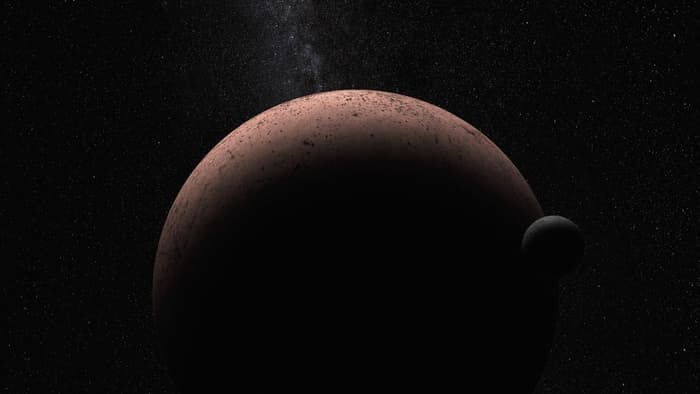A team of astronomers have discovered a new moon hiding in plain sight in the outskirts of our solar system, orbiting the dwarf planet known as Makemake. Designated as S/2015 (136427), or MK 2 for short, this addition to our little area of the Milky Way could shed light on the enigmatic nature of minor planets traveling about the Kuiper Belt, a region of the solar system beyond the orbit of Neptune.

An artist's impression of MK 2 orbiting Makemake. Image source: NASA.
Makemake is one of five officially recognized minor planets, such as Pluto, that roam this area of our solar system. The new moon orbiting the small icy planet is about 100 miles in diameter, but how has it been able to exist undiscovered up until now?
Much like Pluto, Makemake is coated in a dense layer of methane ice. The reflective properties of the ice caused the dwarf planet to shine up to 1,300 times brighter than MK 2, essentially cloaking the moon in the glare of the planetoid. Only with Hubble’s high-resolution Wide Field Camera 3 were astronomers able to see through the interference and discover the moon.
MK 2, which is about nine times smaller than Makemake, was spotted orbiting the dwarf planet at a distance of 13,000 miles. Observations suggest that MK 2 traverses a circular trajectory with a 12-day orbital period. Of course, further analysis of the moon’s orbit will be needed to confirm this.

An image from Hubble of Makemake and MK 2. Image source: NASA.
Confirmation of a circular orbit would support the theory that at some point in the last several billion years, MK 2 collided with Makemake and was drawn in to a stable orbit by the dwarf planet’s gravitational pull. A more elongated orbit would suggest that MK 2 was captured following a close proximity pass of the planetoid that did not involve a direct collision.
Astronomers believe MK 2’s weak gravitational influence was unable to maintain a covering of methane ice, which exposed the moon’s charcoal-black surface, allowing it to become warmed by sunlight.
Similar to how observations of Pluto’s moon Charon made for a more accurate determination of Pluto’s mass, the discovery of MK 2 will allow for a more comprehensive characterization of Makemake.
Source: Science Alert
Advertisement
Learn more about Electronic Products Magazine





